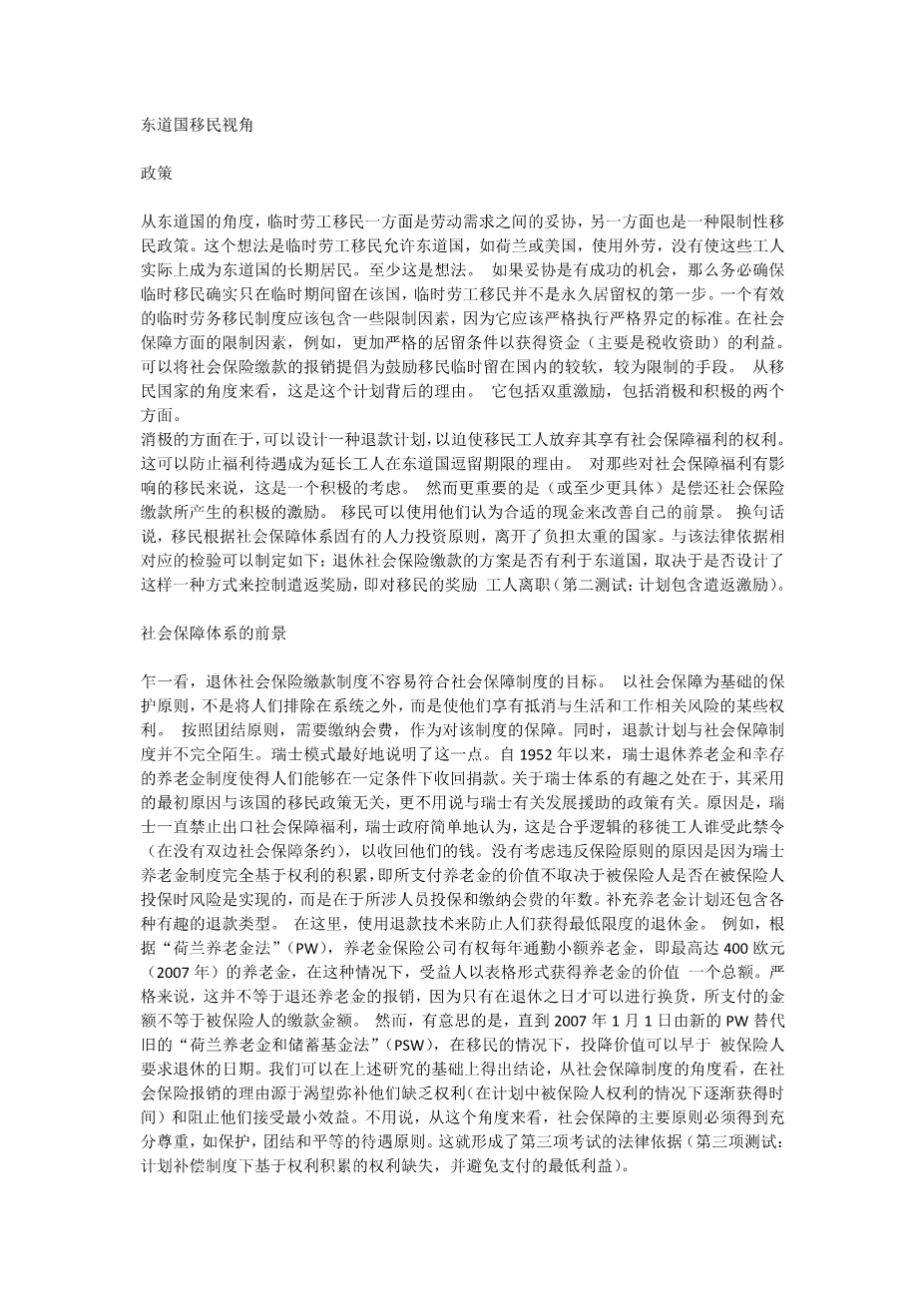THE PERSPECTIVE OF THE HOST COUNTRY’S IMMIGRATION
1.POLICY
From the host country’s perspective, temporary labour migration is a compromise between the need for labour on the one hand and a restrictive immigration policy on the other. The thinking is that temporary labour migration allows a host country, such as the Netherlands or the United States, to make use of foreign workers without these workers actually becoming long-term residents of the host country. That, at least, is the idea. If the compromise is to have any chance of success, it is important to ensure that temporary migrants do indeed remain in the country only for a temporary period, and that temporary labour migration is not the first step on the road to permanent residence. An effective system of temporary labour migration should contain certain restrictive elements, in that it should be associated with strictly defined standards that are rigorously enforced. Restrictive elements in the context of social security are, for instance, tougher residence conditions for eligibility to (mainly tax-financed) benefits.The reimbursement of social insurance contributions could here be advocated as a softer, lesser restrictive instrument for encouraging migrants to remain in the country on a temporary basis. This is the rationale behind such scheme from the point of view of the immigration countries. It includes a twofold incentive, with both negative and positive aspects.
The negative aspect lies in the fact that a refund scheme can be designed in such a way as to force migrant workers to waive their rights to social security benefits. This prevents benefit entitlements from becoming a reason for extending the duration of the worker’s stay in the host country. This should be a positive consideration for those with concerns about social security benefits having a magnetic effect on migrants. More important, however (or at least more tangible), is the positive incentive resulting from the reimbursement of social insurance contributions. Migrants are given cash that they can use as they see fit to improve their own prospects. In other words, migrants leave the country with a ‘knapsack’ on their backs, in line with the principle of human investment that is inherent to the social security system.
The test corresponding with this legal basis may be formulated as follows: whether a scheme for refunding social insurance contributions is conducive to the host country depends on whether it has been designed in such a way as to contain a repatriation bonus, i.e. an incentive for migrant workers to leave (second test: scheme contains repatriation incentive).
2.THE PERSPECTIVE OF THE SOCIAL SECURITY SYSTEM
At first sight, a system of refunding social insurance contributions is not readily compatible with the aims of a social security system. The principle of protection, on which social security is based, is intended not to exclude people from the system, but rather to enable them to enjoy certain rights that offset the risks associated with life and work. In accordance with the principle of solidarity, contributions need to be paid in return for the protection afforded by the system.
At the same time, refund schemes are not totally alien to social security systems. This is best illustrated by the Swiss model. Since 1952, the Swiss system of retirement and surviving dependant’s pensions has allowed people to recover their contributions, subject to certain conditions. The interesting thing about the Swiss system is that the original reason for its adoption had nothing to do with the country’s migration policy, let alone with Swiss policy on development aid. The reason is that the Swiss have always banned the export of social security benefits, and the Swiss government simply decided that it was logical for migrant workers who were affected by this ban (in the absence of a bilateral social security treaty) to get their money back. The reason that this was not considered to run against the principle of insurance is because the Swiss pension system is based entirely on the accumulation of rights, i.e. the value of the pension paid depends not on whether the insured person is insured at the time the insured risk materialises, but rather on the number of years during which the person in question was insured and paid contributions.
Supplementary pension schemes also contain various interesting types of refunds. Here, the technique of a refund is used in order to prevent people from receiving a minimal pension. For instance, under the Dutch Pension Act (PW) pension insurers are entitled to commute small pensions, i.e. pensions up to a maximum of €400 (in 2007) per year, in which case the beneficiaries receive the value of the pension in the form of a lump sum.。Strictly speaking, this is not tantamount to the reimbursement of pension contributions, as the commutation can be effected only at the date of retirement and the amount paid is not equivalent to the value of the contributions paid by the insured person. However, it is interesting to note that, until the replacement of the old Dutch Pension and Savings Funds Act (PSW) by the new PW on 1 January 2007, in the event of migration, the surrender value could be paid at an earlier date than the date of retirement if requested by the insured person.
We may conclude on the basis of the above that, from the perspective of the social security system, the rationale behind the reimbursement of social insurance contributions stems from a desire to compensate people for their lack of rights (in the case of schemes in which insured persons gradually acquire rights over time) and to prevent people from receiving minimal benefits. It goes without saying that from that perspective, the main principles of social security have to be fully respected, such as the principles of protection, solidarity and equal treatment. Thi
剩余内容已隐藏,支付完成后下载完整资料
英语译文共 1 页,剩余内容已隐藏,支付完成后下载完整资料
资料编号:[484320],资料为PDF文档或Word文档,PDF文档可免费转换为Word
以上是毕业论文外文翻译,课题毕业论文、任务书、文献综述、开题报告、程序设计、图纸设计等资料可联系客服协助查找。




